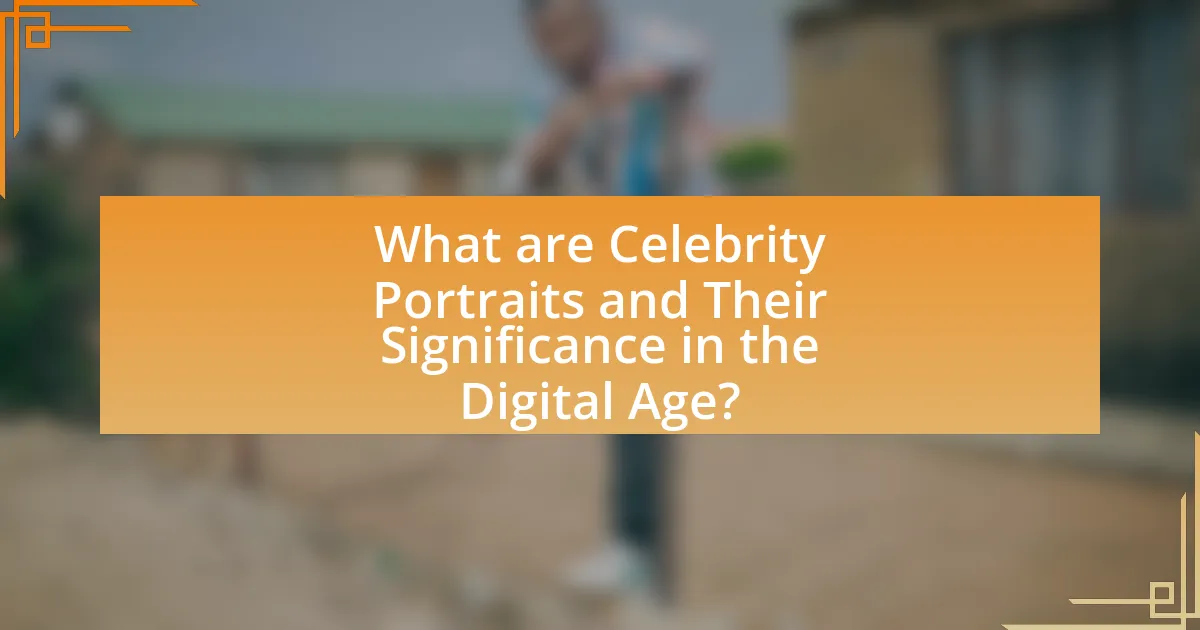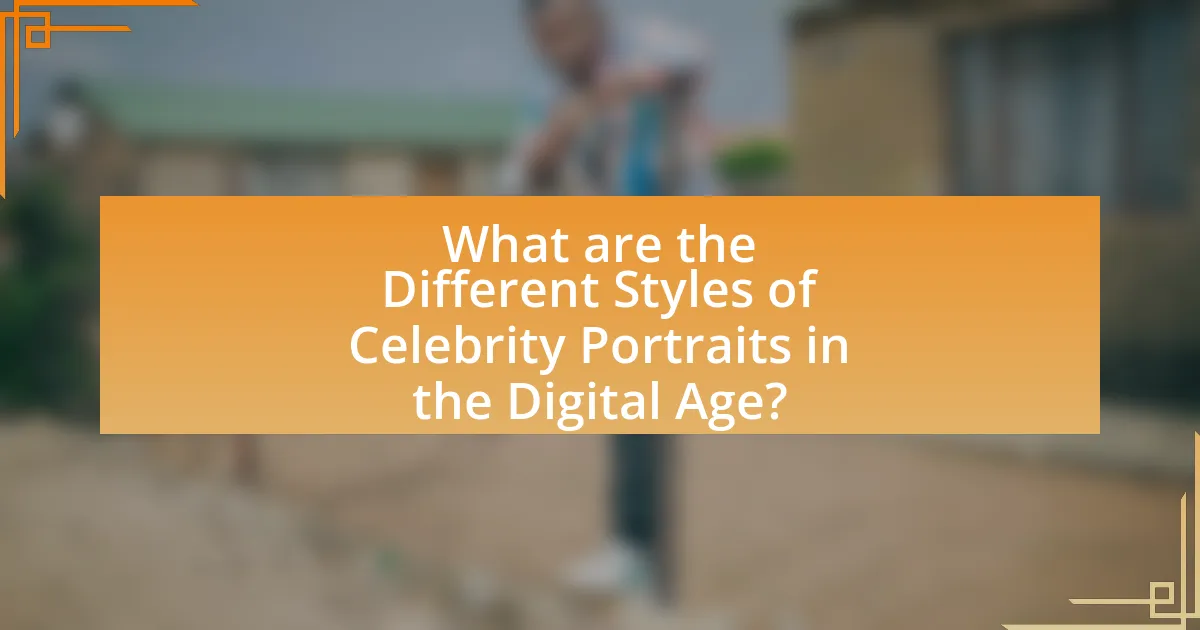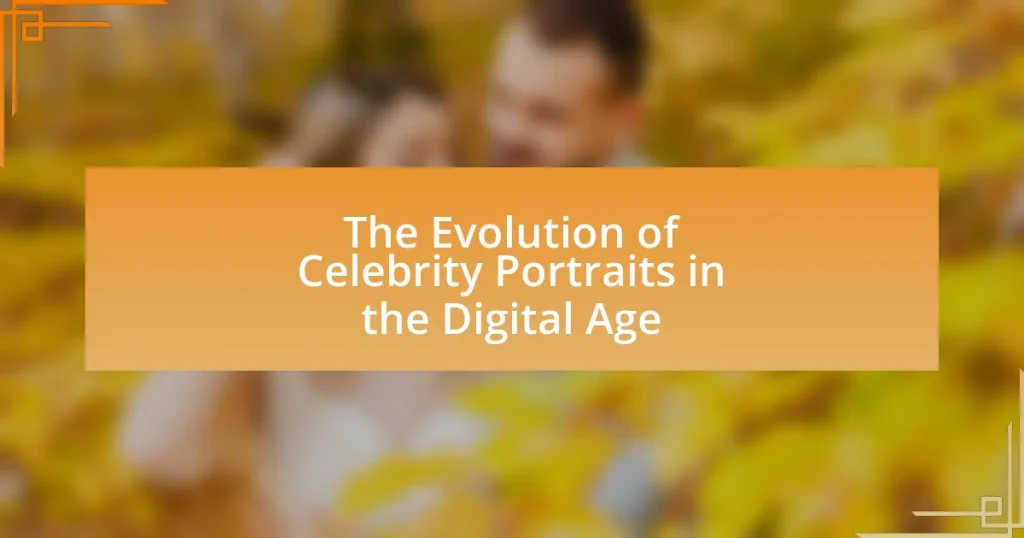Celebrity portraits are visual representations of famous individuals that have evolved significantly in the digital age, driven by advancements in technology and the rise of social media platforms. These portraits serve not only as cultural artifacts but also as powerful tools for branding and marketing, influencing public perception and consumer behavior. The article explores the transformation of celebrity portraits from traditional photography to modern digital techniques, the impact of social media on their dissemination, and the ethical considerations surrounding their creation and use. Additionally, it examines emerging trends in portrait photography, the role of artificial intelligence, and best practices for aspiring photographers in navigating this dynamic landscape.

What are Celebrity Portraits and Their Significance in the Digital Age?
Celebrity portraits are visual representations of famous individuals, often created through photography or digital art, that capture their likeness and persona. In the digital age, these portraits hold significant cultural and commercial value, serving as tools for branding, marketing, and social media engagement. The rise of platforms like Instagram has transformed how celebrity portraits are shared and consumed, allowing for immediate interaction and feedback from audiences. This shift has led to a democratization of celebrity culture, where fans can engage directly with their idols, influencing public perception and trends. Additionally, the accessibility of digital tools has enabled a broader range of artists to create and distribute celebrity portraits, further enriching the visual landscape of contemporary culture.
How have celebrity portraits evolved with technological advancements?
Celebrity portraits have evolved significantly due to technological advancements, transitioning from traditional photography to digital imaging and social media platforms. The introduction of digital cameras in the late 1990s allowed for higher resolution images and instant editing capabilities, enhancing the quality and accessibility of celebrity portraits. Additionally, the rise of social media platforms like Instagram has transformed how celebrities present themselves, enabling real-time sharing of images and direct engagement with fans. This shift has led to a more informal and candid style of portraiture, reflecting a departure from the polished, studio-produced images of the past. The use of advanced editing software, such as Adobe Photoshop, has further allowed for creative manipulation of images, resulting in a diverse range of artistic expressions in celebrity portraits.
What role does social media play in the dissemination of celebrity portraits?
Social media serves as a primary platform for the rapid dissemination of celebrity portraits, enabling immediate sharing and widespread visibility. Platforms like Instagram and Twitter allow users to post and share images instantly, reaching millions of followers and facilitating viral trends. For instance, a study by the Pew Research Center in 2021 indicated that 72% of American adults use social media, highlighting its extensive reach. This accessibility allows fans and media outlets to circulate celebrity portraits quickly, influencing public perception and engagement with celebrities.
How has the accessibility of photography changed the way celebrity portraits are created?
The accessibility of photography has significantly transformed the creation of celebrity portraits by enabling a broader range of photographers to capture images, leading to diverse styles and perspectives. With the advent of smartphones and affordable digital cameras, individuals can now take high-quality photographs, which democratizes the art of portraiture. This shift has resulted in an increase in candid and spontaneous images of celebrities, moving away from traditional, staged portraits typically produced by professional photographers. As a result, platforms like social media have become vital for celebrities to share these authentic representations, allowing fans to connect with them on a more personal level. The proliferation of photography tools has also led to a rise in user-generated content, where fans and amateur photographers contribute to the visual narrative surrounding celebrities, further diversifying the portrayal of public figures.
Why are celebrity portraits important in contemporary culture?
Celebrity portraits are important in contemporary culture because they serve as visual representations of societal values, trends, and aspirations. These images influence public perception and shape cultural narratives, often reflecting the ideals of beauty, success, and lifestyle that resonate with audiences. For instance, the rise of social media platforms has amplified the impact of celebrity portraits, making them central to branding and marketing strategies, as evidenced by the fact that 70% of consumers are influenced by social media in their purchasing decisions. This underscores the role of celebrity imagery in driving consumer behavior and cultural conversations.
What impact do celebrity portraits have on public perception and branding?
Celebrity portraits significantly influence public perception and branding by shaping consumer attitudes and emotional connections to brands. These images often evoke admiration and aspiration, leading to increased brand loyalty and recognition. For instance, a study by the Journal of Advertising Research found that brands endorsed by celebrities can see a 20% increase in consumer purchase intent. Additionally, the visual appeal of celebrity portraits can enhance brand identity, making it more relatable and desirable to target audiences. This connection is particularly potent in the digital age, where social media amplifies the reach and impact of these portraits, allowing brands to engage with consumers on a more personal level.
How do celebrity portraits influence trends in fashion and lifestyle?
Celebrity portraits significantly influence trends in fashion and lifestyle by shaping public perception and consumer behavior. When celebrities are photographed in specific outfits or settings, these images often go viral on social media platforms, leading to increased demand for similar styles among the general public. For instance, a study by the Fashion Institute of Technology found that 70% of consumers reported being influenced by celebrity styles when making fashion purchases. This phenomenon is further amplified by endorsements and collaborations between celebrities and fashion brands, which create a direct link between celebrity imagery and consumer trends.

What are the Different Styles of Celebrity Portraits in the Digital Age?
Different styles of celebrity portraits in the digital age include candid photography, editorial portraits, and digitally manipulated images. Candid photography captures celebrities in natural, unposed moments, often conveying authenticity and relatability. Editorial portraits are styled and composed for magazines or promotional materials, emphasizing artistic direction and branding. Digitally manipulated images utilize software to enhance or alter features, creating striking visuals that can evoke specific emotions or themes. These styles reflect the evolving landscape of celebrity representation, driven by social media and digital platforms that prioritize immediacy and visual impact.
How do traditional portrait styles compare to modern digital techniques?
Traditional portrait styles emphasize manual techniques, such as oil painting or charcoal drawing, which require significant skill and time to create detailed representations of subjects. In contrast, modern digital techniques utilize software and tools that allow for rapid editing, manipulation, and enhancement of images, enabling artists to achieve effects that may be difficult or impossible with traditional methods. For example, digital artists can easily adjust colors, textures, and backgrounds, while traditional artists must rely on physical materials and techniques. This shift has led to a broader accessibility of portrait creation, as digital tools can be used by individuals without formal training, contrasting with the historical exclusivity of traditional portraiture, which often required years of practice to master.
What are the characteristics of candid versus posed celebrity portraits?
Candid celebrity portraits capture spontaneous moments, showcasing genuine emotions and interactions, while posed celebrity portraits are carefully arranged, emphasizing control over the subject’s appearance and setting. Candid portraits often feature natural lighting and unplanned compositions, reflecting authenticity, whereas posed portraits utilize studio lighting and deliberate framing to create a polished image. Research indicates that audiences tend to connect more with candid portraits due to their relatable nature, as seen in studies on viewer engagement with celebrity imagery.
How do filters and editing software alter the representation of celebrities?
Filters and editing software significantly alter the representation of celebrities by enhancing their physical appearance and creating idealized images that may not reflect reality. These tools allow for adjustments in skin tone, texture, body shape, and facial features, leading to a polished and often unrealistic portrayal. For instance, a study published in the journal “Body Image” found that exposure to digitally altered images can negatively impact viewers’ body satisfaction and self-esteem, indicating that such representations can shape public perception and expectations of beauty. Consequently, celebrities often become symbols of unattainable standards, influencing societal norms around attractiveness.
What are the emerging trends in celebrity portrait photography?
Emerging trends in celebrity portrait photography include the use of natural lighting, candid moments, and a focus on authenticity. Photographers are increasingly opting for outdoor settings and soft, natural light to create a more relatable and genuine atmosphere, moving away from heavily staged studio shots. Additionally, there is a growing emphasis on capturing unguarded moments that reflect the personality and emotions of the subject, which resonates more with audiences seeking authenticity. This shift is supported by the rise of social media platforms, where spontaneous and real-life portrayals are favored over polished images, aligning with contemporary audience preferences for transparency and relatability in celebrity culture.
How is virtual reality changing the way we experience celebrity portraits?
Virtual reality is transforming the experience of celebrity portraits by allowing viewers to engage with them in immersive, interactive environments. This technology enables fans to step into virtual galleries where they can explore 3D representations of celebrity portraits, enhancing emotional connections and providing a sense of presence that traditional media cannot offer. For instance, platforms like Oculus and HTC Vive have hosted virtual exhibitions featuring famous artworks, allowing users to view celebrity portraits from multiple angles and even interact with the art. This shift not only democratizes access to art but also creates a more personalized and engaging experience, as users can navigate through virtual spaces at their own pace, making the experience more memorable and impactful.
What role does artificial intelligence play in creating celebrity images?
Artificial intelligence plays a significant role in creating celebrity images by enabling advanced image generation, enhancement, and manipulation techniques. AI algorithms, particularly those based on deep learning, can analyze vast datasets of celebrity photographs to generate realistic images or alter existing ones, enhancing features or creating entirely new visuals. For instance, Generative Adversarial Networks (GANs) have been used to produce high-quality images that can mimic the appearance of celebrities, demonstrating AI’s capability to create lifelike representations. This technology has transformed the landscape of digital portraiture, allowing for innovative artistic expressions and marketing strategies in the entertainment industry.

What Challenges and Ethical Considerations Exist in Celebrity Portraits?
Challenges and ethical considerations in celebrity portraits include issues of consent, privacy, and representation. Celebrities often face unauthorized use of their images, leading to potential violations of their rights. For instance, the legal framework surrounding image rights varies by jurisdiction, complicating the ethical landscape for photographers and artists. Additionally, the portrayal of celebrities can perpetuate stereotypes or misrepresent their identities, raising concerns about the impact of such representations on public perception. The rise of digital media has further intensified these challenges, as images can be easily manipulated and disseminated without proper attribution or context, exacerbating ethical dilemmas in the portrayal of public figures.
How do privacy concerns affect the creation and sharing of celebrity portraits?
Privacy concerns significantly impact the creation and sharing of celebrity portraits by limiting the contexts in which these images can be captured and disseminated. Celebrities often face scrutiny regarding their personal lives, leading to legal frameworks such as the Right of Publicity, which protects individuals from unauthorized commercial use of their likeness. For instance, in California, celebrities have successfully sued for damages when their images were used without consent, reinforcing the importance of privacy in portrait creation. Additionally, social media platforms have implemented stricter guidelines regarding the sharing of images to respect individuals’ privacy rights, further influencing how celebrity portraits are produced and shared in the digital landscape.
What are the implications of unauthorized use of celebrity images?
The unauthorized use of celebrity images can lead to significant legal and financial repercussions for individuals and organizations. Celebrities have the right to control the commercial use of their likeness under laws such as the right of publicity, which varies by jurisdiction. For instance, in California, unauthorized use can result in lawsuits seeking damages that may include lost profits and statutory damages, which can reach up to $750,000 per violation. Additionally, unauthorized use can damage a celebrity’s brand and reputation, leading to loss of endorsements and public trust. This legal framework underscores the importance of obtaining consent before using a celebrity’s image for commercial purposes.
How do celebrities navigate their public image through portraiture?
Celebrities navigate their public image through portraiture by carefully selecting visual representations that align with their desired persona and brand. This strategic choice allows them to convey specific emotions, narratives, and aesthetics that resonate with their audience. For instance, high-profile figures often collaborate with renowned photographers to create iconic images that enhance their status and influence. Research indicates that visual content significantly impacts public perception; a study by the Pew Research Center found that 72% of adults engage with visual content more than text, highlighting the importance of portraiture in shaping celebrity narratives.
What are the best practices for aspiring photographers in the digital age?
Aspiring photographers in the digital age should focus on mastering technical skills, developing a unique style, and leveraging social media for exposure. Mastering technical skills involves understanding camera settings, lighting, and post-processing techniques, which are essential for producing high-quality images. Developing a unique style helps photographers stand out in a saturated market, allowing them to create a recognizable brand. Leveraging social media platforms, such as Instagram and Pinterest, enables photographers to showcase their work, connect with potential clients, and engage with a broader audience, which is crucial for building a successful career. According to a survey by the Pew Research Center, 72% of adults use social media, highlighting its importance for visibility and networking in the photography industry.
How can photographers effectively use social media to showcase their work?
Photographers can effectively use social media to showcase their work by consistently posting high-quality images, engaging with their audience, and utilizing relevant hashtags. High-quality images attract attention and demonstrate the photographer’s skill, while regular engagement, such as responding to comments and messages, builds a community around their work. Utilizing relevant hashtags increases visibility, allowing potential clients and followers to discover their portfolio. According to a study by Hootsuite, posts with at least one hashtag receive 12.6% more engagement than those without, highlighting the importance of strategic hashtag use in expanding reach.
What tips can help photographers maintain ethical standards in celebrity portrait photography?
Photographers can maintain ethical standards in celebrity portrait photography by obtaining informed consent from the subjects before capturing images. This practice ensures that celebrities are aware of how their images will be used and allows them to set boundaries regarding their portrayal. Additionally, photographers should respect the privacy of their subjects, avoiding intrusive or exploitative situations that could harm the celebrity’s reputation or personal life. Adhering to industry guidelines, such as those established by the Professional Photographers of America, reinforces ethical practices by promoting respect and integrity in the profession. These measures not only protect the rights of the subjects but also enhance the credibility and professionalism of the photographers.



